Alkali–Silica Reactivity Potential of Aggregates from Different Sources in Pakistan
Abstract
1. Introduction
Alkali silicate + Silicic acid
Silicic acid Alkali silicate
2. Materials and Methods
2.1. Materials and Specimen Preparation
2.2. Experimental Procedures
3. Results and Discussion
3.1. Cement and Coarse Aggregates Characteristics
3.2. Petrographic Examination of Aggregate Sample
3.2.1. Panjkorha River Aggregates
3.2.2. Shavey Drain Aggregates
3.2.3. Kitkot Drain Aggregates
3.2.4. Jandol River Aggregates
3.2.5. Swat River Aggregates
3.3. Expansion Results of Accelerated Mortar Bar
3.4. ASR Effect on Compressive Strength
3.5. ASR Effect on Modulus of Rupture
4. Conclusions
4.1. Main Outcomes of the Study
- Chemical Analysis. The chemical analysis of the cement yielded results that fell within the prescribed limits of ASTM C114. Specifically, the assessment revealed that the cement contained 1.2% free lime, which is well within the standard’s limit of no more than 2% for free lime content in cement. The chemical analysis of the aggregates complied with both ASTM and European standards. In particular, the Jandol River and Swat River aggregates had the highest silica content among all the sources, with values of approximately 94.70% and 92.50%, respectively. In addition, the Loss of Ignition values were elevated in all aggregates.
- Physical Analysis. The cement physical characteristics of the conformed to both ASTM and European (EN) standards. Specifically, the fineness and surface area of the cement exceeded ASTM specifications at over 90% and 2250 cm3/gm, respectively. In addition, the autoclave expansion of the cement, as per ASTM C151 [80], remained well below 0.8%, demonstrating its compliance with established standards. In accordance with ASTM standards, the physical characteristics of all aggregate sources fell within the specified parameters. In particular, Jandool River aggregates exhibited superior resistance to impact, crushing, and abrasion, indicating their robust nature. Conversely, Kitkot Drain aggregates had the lowest impact and crushing values among the tested sources, indicating a lower level of durability. Shavey Drain aggregates, conversely, showed only moderate abrasion resistance.
- Petrographic Analysis. Petrographic examination of the aggregates reveals the presence of reactive minerals, notably peaking at 77% in the Jandool River aggregates, in contrast to minerals from alternative sources that remain within the conventional range. As indicated by ASTM C1260, the Jandool River sample exhibited reactivity, with an expansion of more than 0.2%, while counterparts from other sources exhibited expansions below this threshold after 28 days.
- Compression Test and Flexure Test. The decrease in compressive strength due to ASR exposure varied among samples: Swat River, Panjkorha River, Jandol River, Kitkot Drain, and Shavey Drain, with decreases of 6.40%, 6.32%, 8.22%, 5.31%, and 3.61%, respectively, at the 90-day mark. The reduction in flexural strength under ASR exposure varied among different sources: Swat River, Panjkorha River, Jandool River, Kitkot Drain, and Shavey Drain, exhibiting decreases of 5.7%, 6.49%, 9.2%, 6.8%, and 5.6%, respectively, over the 90-day period.
4.2. Final Observations and Future Developments
Author Contributions
Funding
Institutional Review Board Statement
Informed Consent Statement
Data Availability Statement
Conflicts of Interest
References
- Triassi, M.; Alfano, R.; Illario, M.; Nardone, A.; Caporale, O.; Montuori, P. Environmental Pollution from Illegal Waste Disposal and Health Effects: A Review on the “Triangle of Death”. Int. J. Environ. Res. Public. Health 2015, 12, 1216–1236. [Google Scholar] [CrossRef]
- Cirrincione, L.; La Gennusa, M.; Peri, G.; Rizzo, G.; Scaccianoce, G. The Landfilling of Municipal Solid Waste and the Sustainability of the Related Transportation Activities. Sustainability 2022, 14, 5272. [Google Scholar] [CrossRef]
- Vocciante, M.; Meshalkin, V. An Accurate Inverse Model for the Detection of Leaks in Sealed Landfills. Sustainability 2020, 12, 5598. [Google Scholar] [CrossRef]
- Cachada, A.; Rocha-Santos, T.; Duarte, A.C. Soil and Pollution. In Soil Pollution; Elsevier: Amsterdam, The Netherlands, 2018; pp. 1–28. [Google Scholar]
- Yang, Y.; Zhou, C.; Peng, J.; Li, H.; Dong, Y.; Cai, C.S. Theory-Informed Deep Neural Network-Based Time-Dependent Flexural Reliability Assessment of Corroded PC Structures. Eng. Struct. 2025, 329, 119819. [Google Scholar] [CrossRef]
- Farhadian, M.; Vachelard, C.; Duchez, D.; Larroche, C. In Situ Bioremediation of Monoaromatic Pollutants in Groundwater: A Review. Bioresour. Technol. 2008, 99, 5296–5308. [Google Scholar] [CrossRef]
- Pietrelli, L.; Ferro, S.; Reverberi, A.P.; Vocciante, M. Removal of Polyethylene Glycols from Wastewater: A Comparison of Different Approaches. Chemosphere 2021, 273, 129725. [Google Scholar] [CrossRef] [PubMed]
- de Folly d’Auris, A.; Rubertelli, F.; Taini, A.; Vocciante, M. A Novel Polyurethane-Based Sorbent Material for Oil Spills Management. J. Environ. Chem. Eng. 2023, 11, 111386. [Google Scholar] [CrossRef]
- Liu, Y.; Fei, Y.; Li, Y.; Bao, X.; Zhang, P. A Review of the Pollution Source Identification Methods and Remediation Technologies of Groundwater. China Geol. 2022, 7, 125–137. [Google Scholar] [CrossRef]
- ZAFAR, M.S.; Gatto, F.; Mancini, G.; Lauciello, S.; Pompa, P.; Athanassiou, A.; Fragouli, D. Biocomposite Cryogels for Photothermal Decontamination of Water. Langmuir 2023, 39, 7793–7803. [Google Scholar] [CrossRef]
- Khan, F.I.; Husain, T.; Hejazi, R. An Overview and Analysis of Site Remediation Technologies. J. Environ. Manag. 2004, 71, 95–122. [Google Scholar] [CrossRef]
- Pedron, F.; Grifoni, M.; Barbafieri, M.; Petruzzelli, G.; Franchi, E.; Samà, C.; Gila, L.; Zanardi, S.; Palmery, S.; Proto, A.; et al. New Light on Phytoremediation: The Use of Luminescent Solar Concentrators. Appl. Sci. 2021, 11, 1923. [Google Scholar] [CrossRef]
- Conte, A.; Chiaberge, S.; Pedron, F.; Barbafieri, M.; Petruzzelli, G.; Vocciante, M.; Franchi, E.; Pietrini, I. Dealing with Complex Contamination: A Novel Approach with a Combined Bio-Phytoremediation Strategy and Effective Analytical Techniques. J. Environ. Manag. 2021, 288, 112381. [Google Scholar] [CrossRef] [PubMed]
- Song, P.; Xu, D.; Yue, J.; Ma, Y.; Dong, S.; Feng, J. Recent Advances in Soil Remediation Technology for Heavy Metal Contaminated Sites: A Critical Review. Sci. Total Environ. 2022, 838, 156417. [Google Scholar] [CrossRef]
- Zafar, M.S.; Zahid, M.; Athanassiou, A.; Fragouli, D. Biowaste-Derived Carbonized Bone for Solar Steam Generation and Seawater Desalination. Adv. Sustain. Syst. 2021, 5, 2100031. [Google Scholar] [CrossRef]
- Voit, K.; Zeman, O.; Janotka, I.; Adamcova, R.; Bergmeister, K. High-Durability Concrete Using Eco-Friendly Slag-Pozzolanic Cements and Recycled Aggregate. Appl. Sci. 2020, 10, 8307. [Google Scholar] [CrossRef]
- Yagüe, S.; Rosales-Prieto, V.; Sánchez-Lite, A.; González-Gaya, C. Properties of Green Mortar Containing Granite Sawmill. Appl. Sci. 2021, 11, 2136. [Google Scholar] [CrossRef]
- Hatami Shirkouh, A.; Meftahi, F.; Soliman, A.; Godbout, S.; Palacios, J. Performance of Eco-Friendly Zero-Cement Particle Board under Harsh Environment. Appl. Sci. 2024, 14, 3118. [Google Scholar] [CrossRef]
- Cirrincione, L.; Gennusa, M.L.; Peri, G.; Rizzo, G.; Scaccianoce, G. Foster Carbon-Neutrality in the Built Environment: A Blockchain-Based Approach for the Energy Interaction Among Buildings. In Proceedings of the 2022 Workshop on Blockchain for Renewables Integration (BLORIN), Palermo, Italy, 2–3 September 2022; pp. 167–171. [Google Scholar]
- Llorach-Massana, P.; Cirrincione, L.; Sierra-Perez, J.; Scaccianoce, G.; Gennusa, M.L.; Peña, J.; Rieradevall, J. Environmental Assessment of a New Building Envelope Material Derived from Urban Agriculture Wastes: The Case of the Tomato Plants Stems. Int. J. Life Cycle Assess. 2023, 28, 813–827. [Google Scholar] [CrossRef]
- Yang, Y.; Chen, H.; Peng, J.; Dong, Y. Machine Learning-Based Probabilistic Prediction Model for Chloride Concentration in the Interfacial Zone of Precast and Cast-in-Place Concrete Structures. Structures 2025, 72, 108224. [Google Scholar] [CrossRef]
- Capitano, C.; Cirrincione, L.; Peri, G.; Rizzo, G.; Scaccianoce, G. A Simplified Method for the Indirect Evaluation of the “Embodied Pollution” of Natural Stones (Marble) Working Chain to Be Applied for Achieving the Ecolabel Brand of the Product. J. Clean. Prod. 2022, 362, 132576. [Google Scholar] [CrossRef]
- Fanijo, E.O.; Kolawole, J.T.; Almakrab, A. Alkali-Silica Reaction (ASR) in Concrete Structures: Mechanisms, Effects and Evaluation Test Methods Adopted in the United States. Case Stud. Constr. Mater. 2021, 15, 563. [Google Scholar] [CrossRef]
- Tosun, K.; Felekoğlu, B.; Baradan, B. The Effect of Cement Alkali Content on ASR Susceptibility of Mortars Incorporating Admixtures. Build. Environ. 2007, 42, 3444–3453. [Google Scholar] [CrossRef]
- Mo, K.H.; Ling, T.-C.; Tan, T.H.; Leong, G.W.; Yuen, C.W.; Shah, S.N. Alkali-Silica Reactivity of Lightweight Aggregate: A Brief Overview. Constr. Build. Mater. 2021, 270, 121444. [Google Scholar] [CrossRef]
- Ichikawa, T.; Miura, M. Modified Model of Alkali-Silica Reaction. Cem. Concr. Res. 2007, 37, 1291–1297. [Google Scholar] [CrossRef]
- Stanton, T.E. Expansion of Concrete through Reaction between Cement and Aggregate. Trans. Am. Soc. Civil. Eng. 1942, 107, 54–84. [Google Scholar] [CrossRef]
- Chrisp, T.M.; Waldron, P.; Wood, J.G.M. Development of a Non-Destructive Test to Quantify Damage in Deteriorated Concrete. Mag. Concr. Res. 1993, 45, 247–256. [Google Scholar] [CrossRef]
- Peri, G.; Cirrincione, L.; Mazzeo, D.; Matera, N.; Scaccianoce, G. Building Resilience to a Warming World: A Contribution toward a Definition of “Integrated Climate Resilience” Specific for Buildings—Literature Review and Proposals. Energy Build. 2024, 315, 114319. [Google Scholar] [CrossRef]
- Peri, G.; Licciardi, G.R.; Matera, N.; Mazzeo, D.; Cirrincione, L.; Scaccianoce, G. Disposal of Green Roofs: A Contribution to Identifying an “Allowed by Legislation” End–of–Life Scenario and Facilitating Their Environmental Analysis. Build. Environ. 2022, 226, 109739. [Google Scholar] [CrossRef]
- Thomas, M.D.A.; Innis, F.A. Effect of Slag on Expansion Due to Alkali Aggregate Reaction in Concrete. ACI Mater J. 1998, 95, 716–724. [Google Scholar] [CrossRef]
- Shafaatian, S.M.H.; Akhavan, A.; Maraghechi, H.; Rajabipour, F. How Does Fly Ash Mitigate Alkali–Silica Reaction (ASR) in Accelerated Mortar Bar Test (ASTM C1567)? Cem. Concr. Compos. 2013, 37, 143–153. [Google Scholar] [CrossRef]
- Shehata, M.H.; Thomas, M.D.A. Use of Ternary Blends Containing Silica Fume and Fly Ash to Suppress Expansion Due to Alkali–Silica Reaction in Concrete. Cem. Concr. Res. 2002, 32, 341–349. [Google Scholar] [CrossRef]
- Lumley, J.S. ASR Suppression by Lithium Compounds. Cem. Concr. Res. 1997, 27, 235–244. [Google Scholar] [CrossRef]
- Luo, D.; Sinha, A.; Adhikari, M.; Wei, J. Mitigating Alkali-Silica Reaction through Metakaolin-Based Internal Conditioning: New Insights into Property Evolution and Mitigation Mechanism. Cem. Concr. Res. 2022, 159, 106888. [Google Scholar] [CrossRef]
- Godart, B.; de Rooij, M.R.; Wood, J.G. Guide to Diagnosis and Appraisal of AAR Damage to Concrete in Structures; Springer: Dordrecht, The Netherlands, 2013. [Google Scholar]
- Munir, M.J.; Abbas, S.; Qazi, A.U.; Nehdi, M.L.; Kazmi, S.M.S. Role of Test Method in Detection of Alkali–Silica Reactivity of Concrete Aggregates. Proc. Inst. Civil. Eng. Constr. Mater. 2018, 171, 203–221. [Google Scholar] [CrossRef]
- C1260-23; Standard Test Method for Potential Alkali Reactivity of Aggregates (Mortar-Bar Method). ASTM: West Conshohocken, PA, USA, 2007.
- Marzouk, H.; Langdon, S. The Effect of Alkali-Aggregate Reactivity on the Mechanical Properties of High and Normal Strength Concrete. Cem. Concr. Compos. 2003, 25, 549–556. [Google Scholar] [CrossRef]
- Islam, M.S.; Ghafoori, N. Relation of ASR-Induced Expansion and Compressive Strength of Concrete. Mater. Struct. 2015, 48, 4055–4066. [Google Scholar] [CrossRef]
- Na, O.; Xi, Y.; Ou, E.; Saouma, V.E. The Effects of Alkali-Silica Reaction on the Mechanical Properties of Concretes with Three Different Types of Reactive Aggregate. Struct. Concr. 2016, 17, 74–83. [Google Scholar] [CrossRef]
- Oberholster, R.E.; Davies, G. An Accelerated Method for Testing the Potential Alkali Reactivity of Siliceous Aggregates. Cem. Concr. Res. 1986, 16, 181–189. [Google Scholar] [CrossRef]
- C227; Standard Test Method for Potential Alkali Reactivity of Cement-Aggregate Combinations (Mortar-Bar Method). ASTM: West Conshohocken, PA, USA, 2018.
- Abbas, S.; Hussain, I.; Aslam, F.; Ahmed, A.; Gillani, S.A.A.; Shabbir, A.; Deifalla, A.F. Potential of Alkali–Silica Reactivity of Unexplored Local Aggregates as per ASTM C1260. Materials 2022, 15, 6627. [Google Scholar] [CrossRef]
- Hassan, E.U.L.; Hannan, A.; Rashid, M.U.R.; Ahmed, W.; Zeb, M.J.; Khan, S.; Abbas, S.A.; Ahmad, A. Resource Assessment of Sakesar Limestone as Aggregate from Salt Range Pakistan Based on Geotechnical Properties. Int. J. Hydrol. 2020, 4, 24–29. [Google Scholar] [CrossRef]
- Hakim, R.; Mehmood, K.; Ahad, M.Z.; Hakim, I. Engineering Characterization of Course Aggregate Used in Cement Concrete from Local Quarries in Dir (Lower), KP, Pakistan. Int. J. Sci. Eng. Res. 2018, 9, 1–6. [Google Scholar]
- Pathan, M.A.; Lashae-Ri, R.A.; Maira, M.; Professor, A.; Professor, A. A Study on Types and Quality of Aggregates Produced in LONI KOT Karachi-Hyderabad Motorway Used in Building Construction. Int. J. Eng. Sci. Comput. 2018, 8, 17870. [Google Scholar]
- Munir, M.J.; Kazmi, S.M.S.; Wu, Y.-F. Efficiency of Waste Marble Powder in Controlling Alkali–Silica Reaction of Concrete: A Sustainable Approach. Constr. Build. Mater. 2017, 154, 590–599. [Google Scholar] [CrossRef]
- Munir, M.J.; Abbas, S.; Minhaj, S.; Kazmi, S.; Khitab, A.; Ashiq, S.Z.; Arshad, M.T. Engineering Characteristics of Widely Used Coarse Aggregates in Pakistan: A Comparative Study. Pak. J. Engg. Appl. Sci. 2017, 20, 85–93. [Google Scholar]
- Naseem, S.; Hussain, K.; Shahab, B.; Bashir, E.; Bilal, M.; Hamza, S. Investigation of Carbonate Rocks of Malikhore Formation as Coarse Aggregate and Dimension Stone, SE Balochistan, Pakistan. Br. J. Appl. Sci. Technol. 2016, 12, 1–11. [Google Scholar] [CrossRef]
- Qureshi, M.A.; Aslam, M.; Shah, A.N.R.; Otho, S.H. Influence of Aggregate Characteristics on the Compressive Strength. Tech. J. Univ. Eng. Technol. Taxila 2015, 20, 1–10. [Google Scholar]
- Naeem, M.; Khalid, P.; Sanaullah, M.; ud Din, Z. Physio-Mechanical and Aggregate Properties of Limestones from Pakistan. Acta Geod. Geophys. 2014, 49, 369–380. [Google Scholar] [CrossRef]
- Siddiqi, Z.A.; Hameed, R.; Saleem, M.; Khan, Q.S.; Ishaq, I. Performance Study of Locally Available Coarse Aggregates of Azad Kashmir. Pak. J. Sci. 2013, 65, 90–94. [Google Scholar]
- Ayub, M.; Shahzada, K.; Profile, S.; Naseer, A.; Shoaib, M. Engineering Assessment of Coarse Aggregates Used in Peshawar. Int. J. Adv. Struct. Geotech. Eng. 2012, 1, 61–64. [Google Scholar]
- Gondal, M.M.I.; Ahsan, N.; Javid, A.Z. Engineering Properties of Potential Aggregate Resources from Eastern and Central Salt Range, Pakistan. Geol. Bull. Punjab Univ. 2009, 44, 97–103. [Google Scholar]
- Ahsan, N.; Chaudhry, M.N.; Gondal, M.M.I.; Khan, Z.K. Allai Aggregate for Rehabilitation and Reconstruction of October 8, 2005 Earthquake Affected Allai-Banan Area, NWFP, Pakistan. Geol. Bull. Punjab Univ. 2009, 44, 1–12. [Google Scholar]
- Gondal, M.M.I.; Ahsan, N.; Javid, A.Z. Evaluation of Shaki Sarwar and Rajan Pur Aggregates for Construction in Southern Punjab Province, Pakistan. Geol. Bull. Punjab Univ. 2008, 43, 101–107. [Google Scholar]
- Kamal, M.A.; Sulehri, M.A.; Hughes, D.A.B. Engineering Characteristics of Road Aggregates from Northern Pakistan and the Development of a Toughness Index. Geotech. Geol. Eng. 2006, 24, 819–831. [Google Scholar] [CrossRef]
- Cement–Part 1, Composition, Specifications and Conformity Criteria for Common Cements; BSI: Herndon, VA, USA, 2000; ISBN 0580364569.
- ASTM C204; Standard Test Methods for Fineness of Hydraulic Cement by Air-Permeability Apparatus. ASTM: West Conshohocken, PA, USA, 2023.
- ASTM C184-94e1; Standard Test Method for Fineness of Hydraulic Cement by the 150-µm (No. 100) and 75-µm (No. 200) Sieves (Withdrawn 2002). ASTM: West Conshohocken, PA, USA, 2002.
- ASTM C191-21; Standard Test Methods for Time of Setting of Hydraulic Cement by Vicat Needle. ASTM: West Conshohocken, PA, USA, 2021.
- ASTM C187-16; Standard Test Method for Amount of Water Required for Normal Consistency of Hydraulic Cement Paste. ASTM: West Conshohocken, PA, USA, 2023.
- Kamani, M.; Ajalloeian, R. Evaluation of the Mechanical Degradation of Carbonate Aggregate by Rock Strength Tests. J. Rock. Mech. Geotech. Eng. 2019, 11, 121–134. [Google Scholar] [CrossRef]
- Mohajerani, A.; Nguyen, B.T.; Tanriverdi, Y.; Chandrawanka, K. A New Practical Method for Determining the LA Abrasion Value for Aggregates. Soils Found. 2017, 57, 840–848. [Google Scholar] [CrossRef]
- ASTM C535-16; Standard Test Method for Resistance to Degradation of Large-Size Coarse Aggregate by Abrasion and Impact in the Los Angeles Machine. ASTM: West Conshohocken, PA, USA, 2024.
- ASTM C29/C29M-97; Standard Test Method for Bulk Density (“Unit Weight”) and Voids in Aggregate. ASTM: West Conshohocken, PA, USA, 2023.
- ASTM C127-15; Standard Test Method for Relative Density (Specific Gravity) and Absorption of Coarse Aggregate (Withdrawn 2024). ASTM: West Conshohocken, PA, USA, 2024.
- ASTM C114-18; Standard Test Methods for Chemical Analysis of Hydraulic Cement. ASTM: West Conshohocken, PA, USA, 2022.
- ASTM C295-08; Standard Guide for Petrographic Examination of Aggregates for Concrete. ASTM: West Conshohocken, PA, USA, 2011.
- ASTM C109/C109M-20; Standard Test Method for Compressive Strength of Hydraulic Cement Mortars (Using 2-in. or [50-Mm] Cube Specimens). ASTM: West Conshohocken, PA, USA, 2020.
- ASTM C348-21; Standard Test Method for Flexural Strength of Hydraulic-Cement Mortars. ASTM: West Conshohocken, PA, USA, 2021.
- ASTM C490/C490M-21; Standard Practice for Use of Apparatus for the Determination of Length Change of Hardened Cement Paste, Mortar, and Concrete. ASTM: West Conshohocken, PA, USA, 2021.
- Leemann, A.; Le Saout, G.; Winnefeld, F.; Rentsch, D.; Lothenbach, B. Alkali–Silica Reaction: The Influence of Calcium on Silica Dissolution and the Formation of Reaction Products. J. Am. Ceram. Soc. 2011, 94, 1243–1249. [Google Scholar] [CrossRef]
- Teo, B.K.; Sun, X.H. Silicon-Based Low-Dimensional Nanomaterials and Nanodevices. Chem. Rev. 2007, 107, 1454–1532. [Google Scholar] [CrossRef]
- Polyakova, I.G. 4. The Main Silica Phases and Some of Their Properties. In Selected Properties and Crystallization; Schmelzer, J.W.P., Ed.; De Gruyter: Berlin, Germany; Boston, MA, USA, 2014; pp. 197–268. ISBN 9783110298581. [Google Scholar]
- Robert, J. Dunham Classification of Carbonate Rocks According to Depositional Textures. In The AAPG/Datapages Combined Publications Database; American Association of Petroleum Geologists: Washington, WA, USA, 1962. [Google Scholar]
- Forster, S.W.; Akers, D.J.; Lee, M.K.; Pergalsky, A.; Arrand, C.D.; Lewis, D.W.; Pierce, J.S.; Barger, G.S.; Macdonald, D.R.; Pisaneschi, R.R.; et al. State-of-the-Art Report on Alkali-Aggregate Reactivity; American Concrete Institute: Farmington Hills, MI, USA, 1998. [Google Scholar]
- Stark, D. Eliminating or Minimizing Alkali-Silica Reactivity; Strategic Highway Research Program, National Research Council: Washington, DC, USA, 1993; ISBN 0309056039. [Google Scholar]
- ASTM C151; Standard Test Method for Autoclave Expansion of Hydraulic Cement. ASTM International: West Conshohocken, PA, USA, 2015.
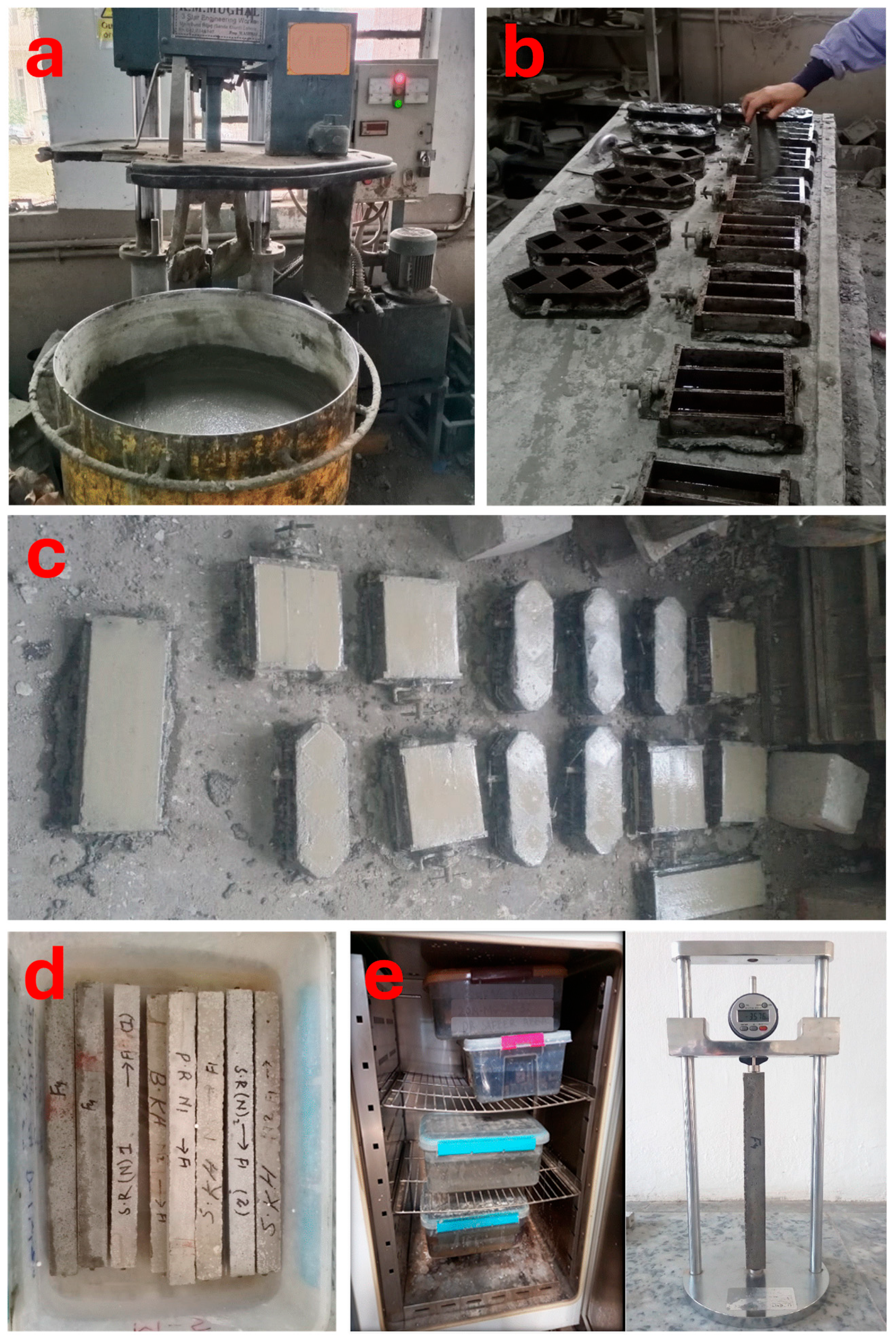
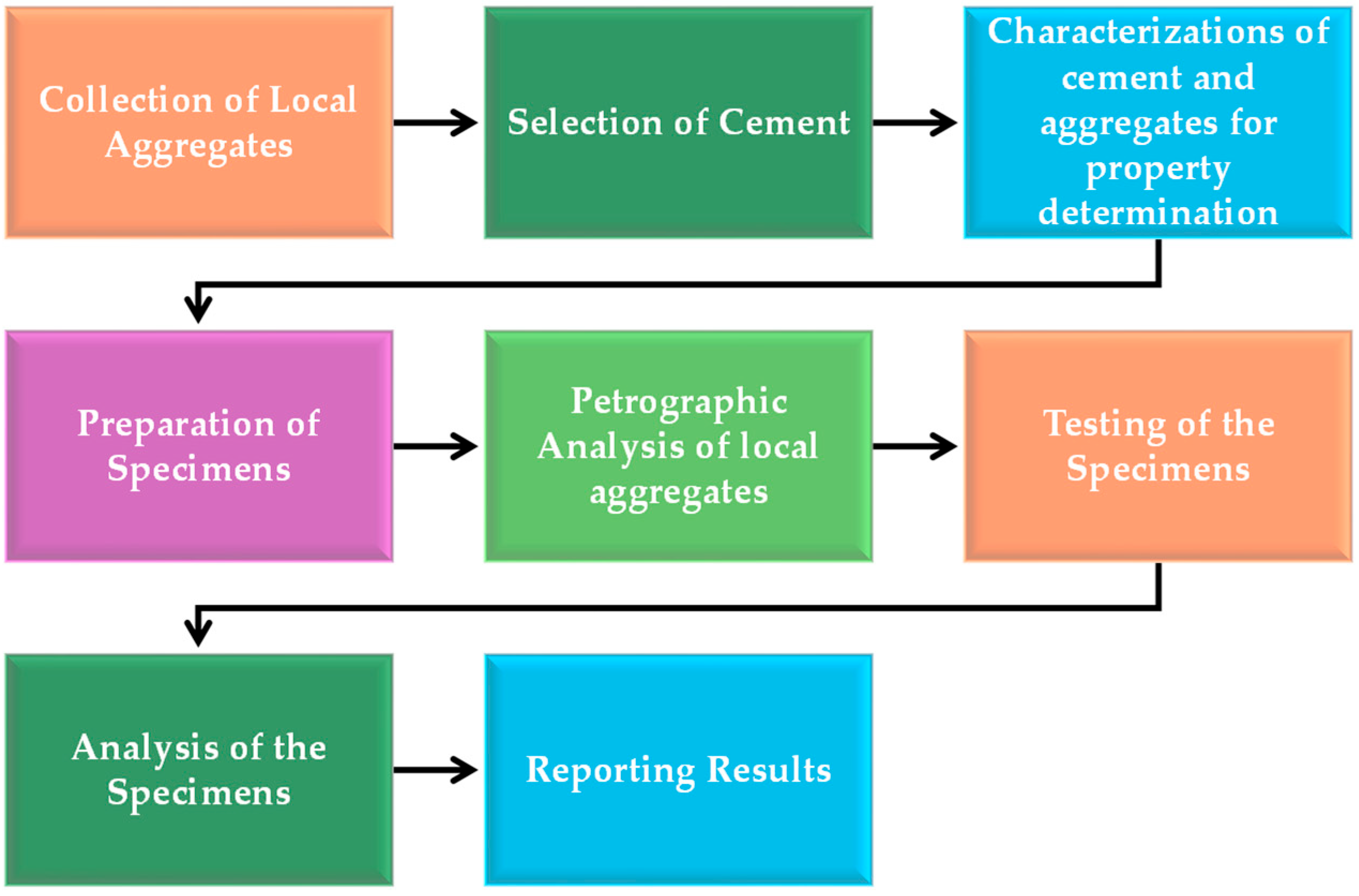
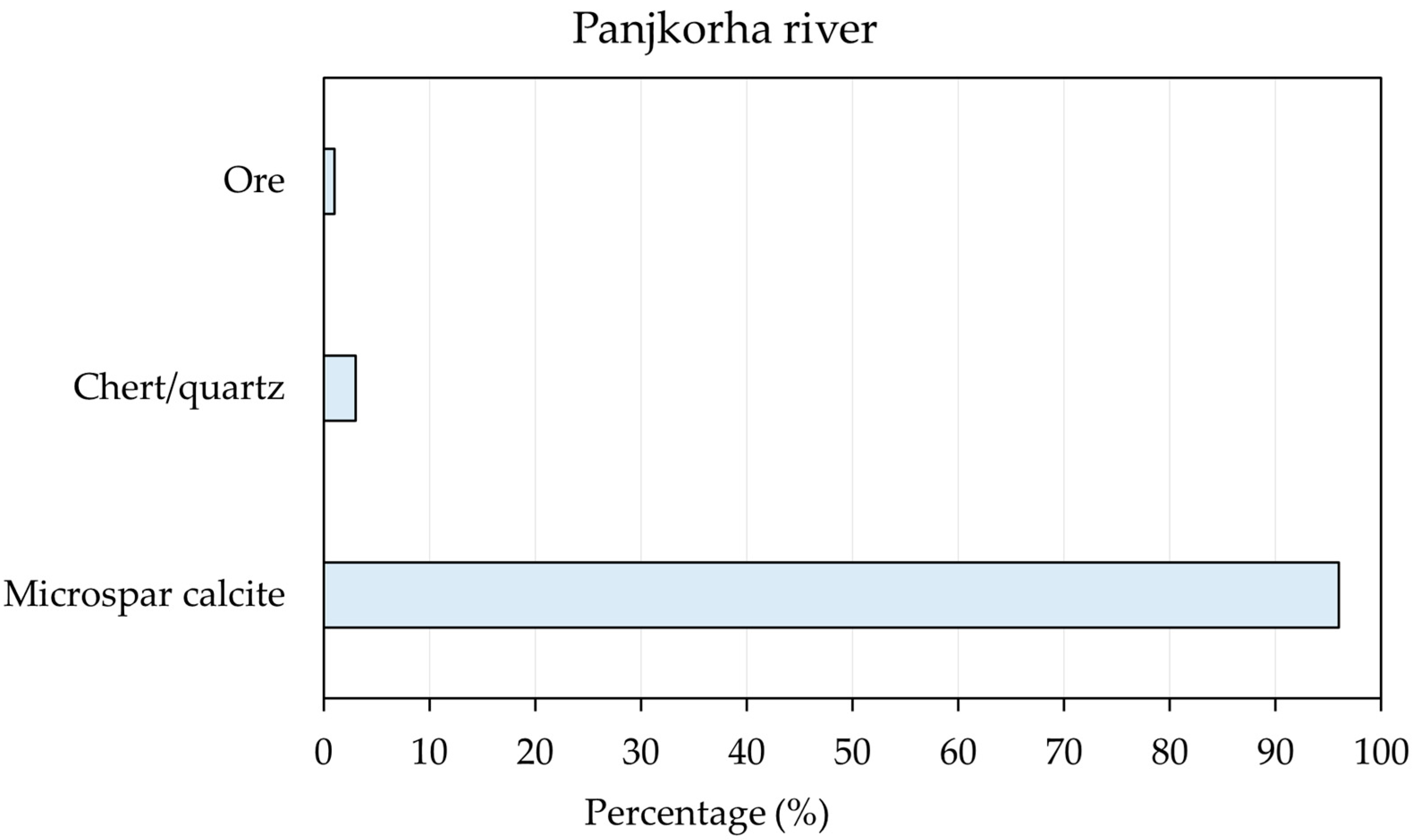
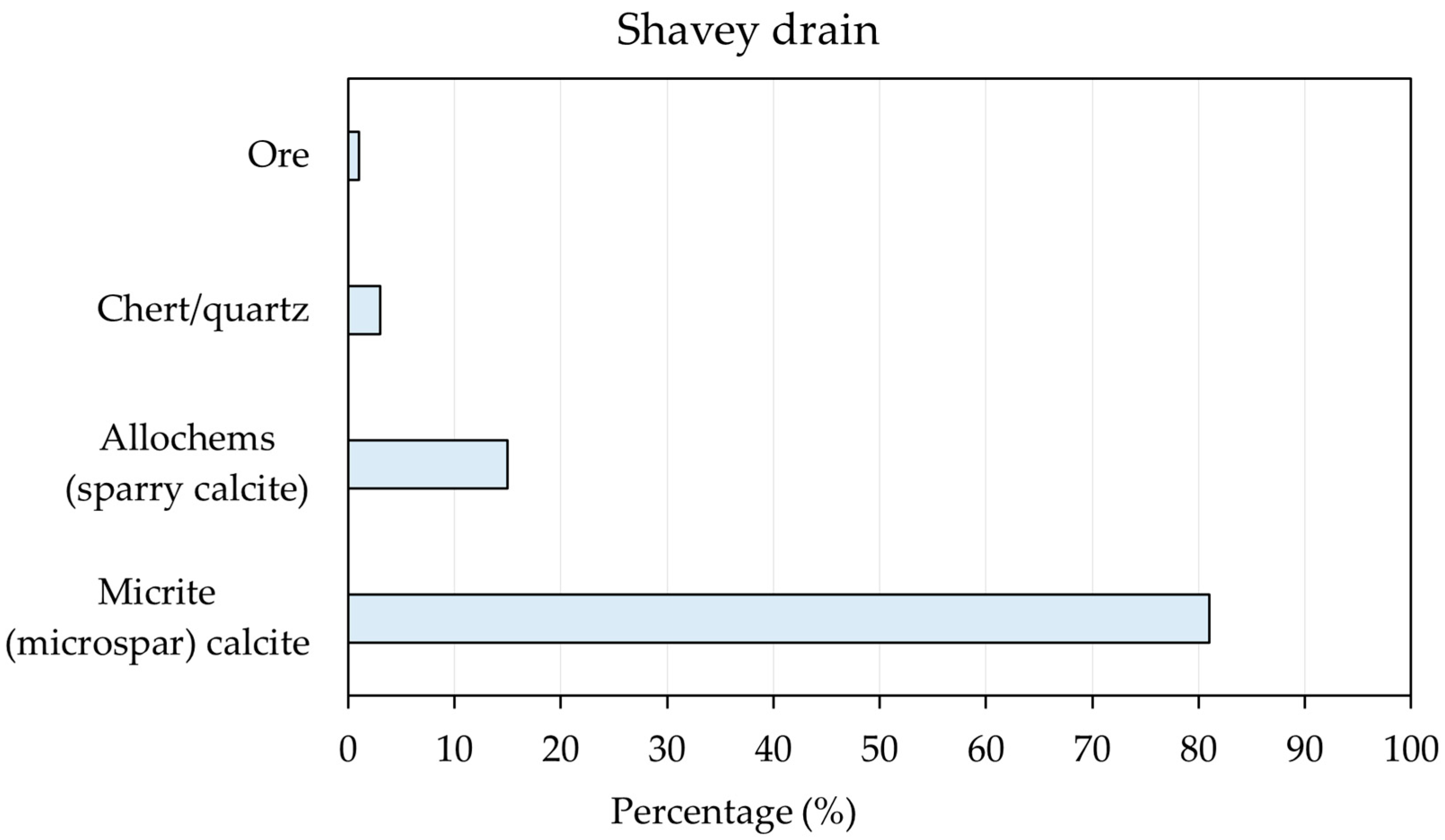
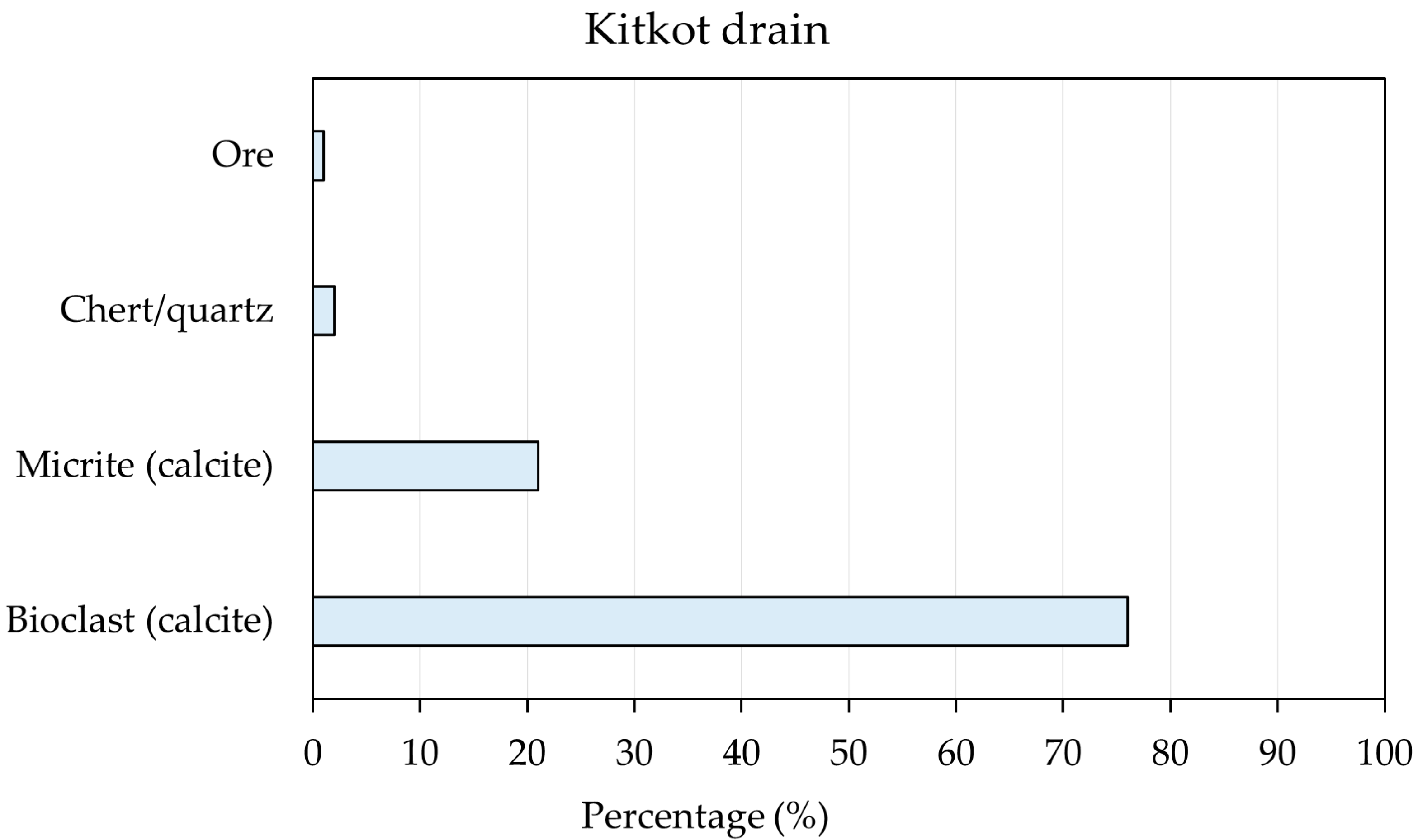
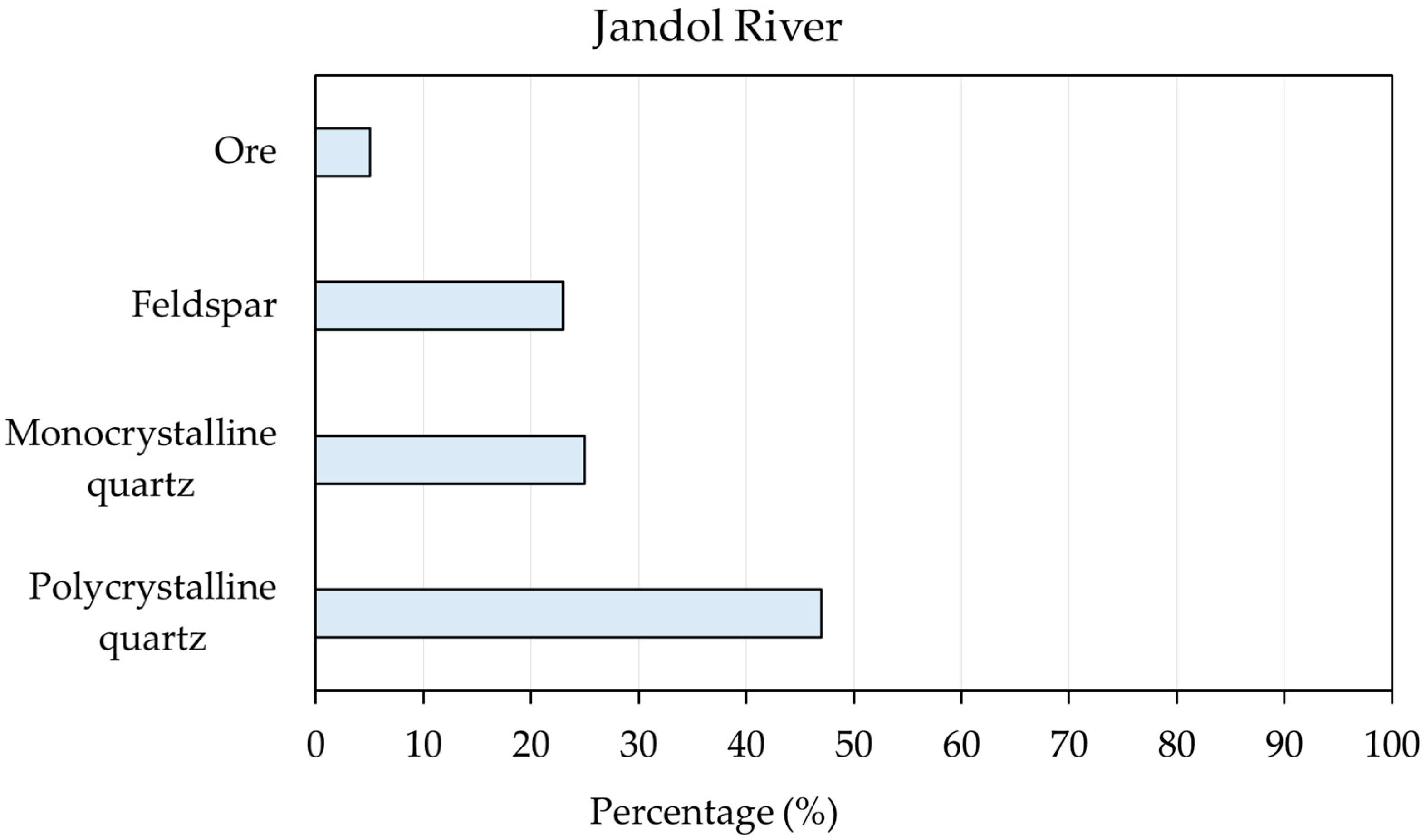
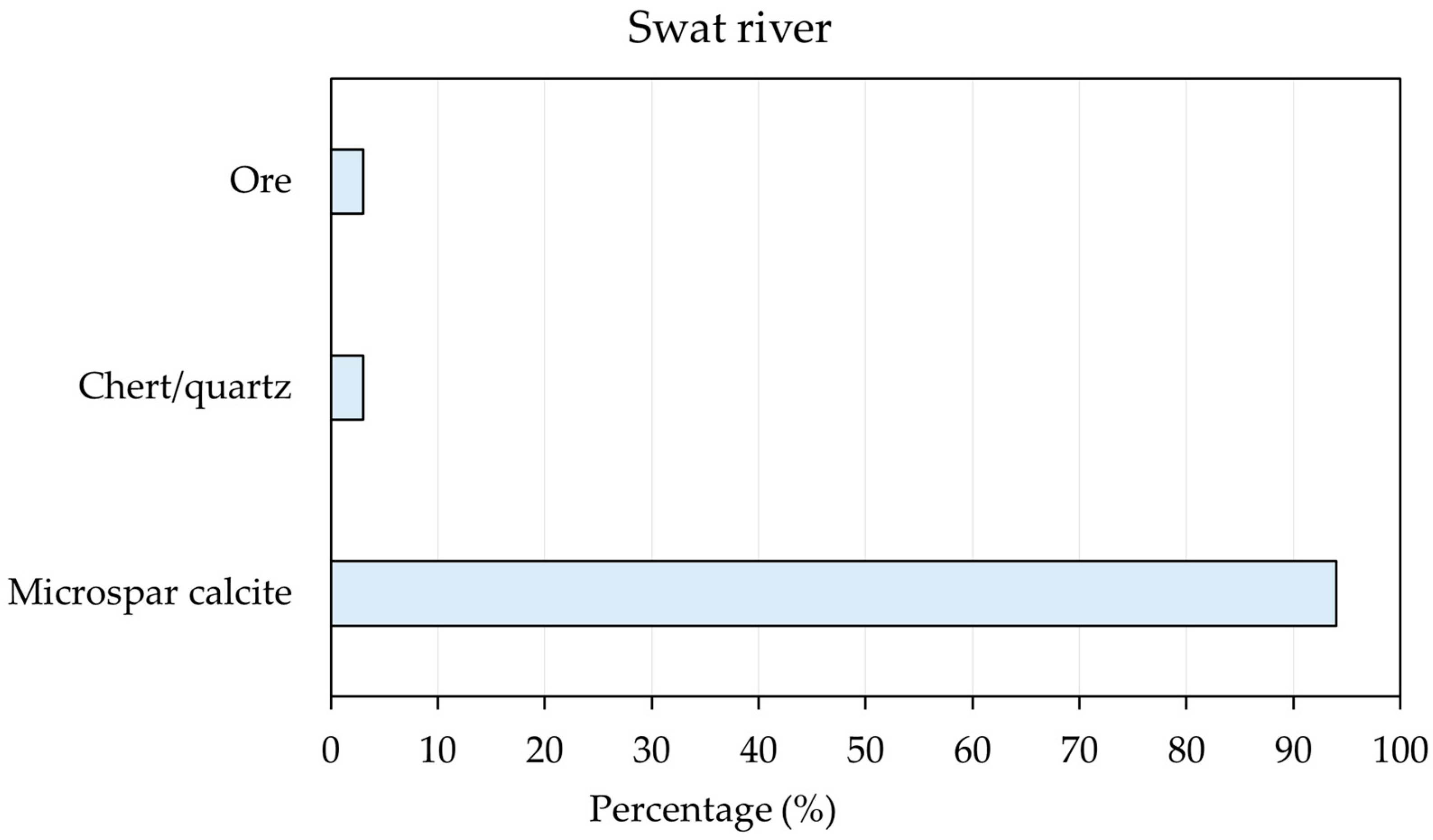
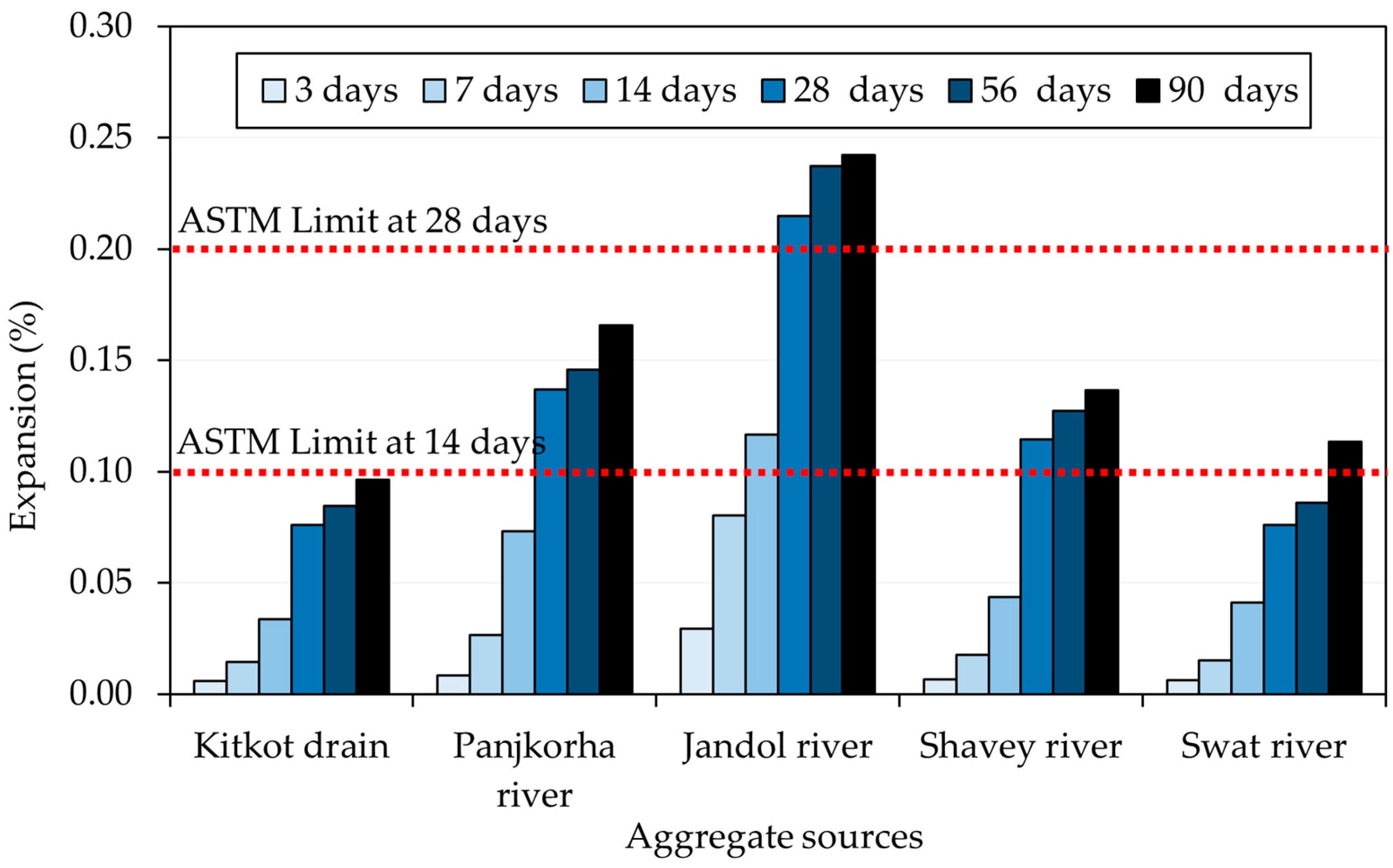
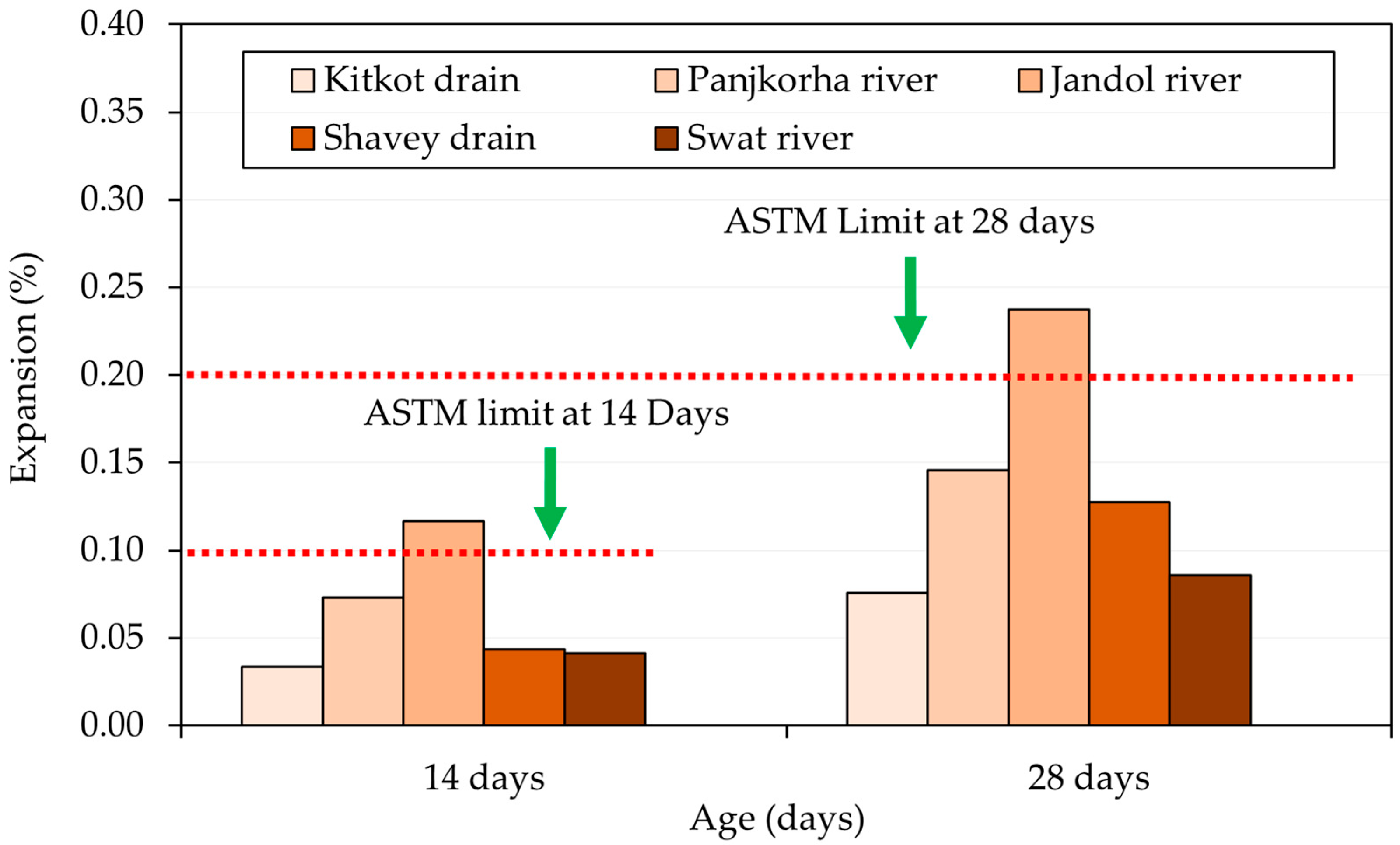
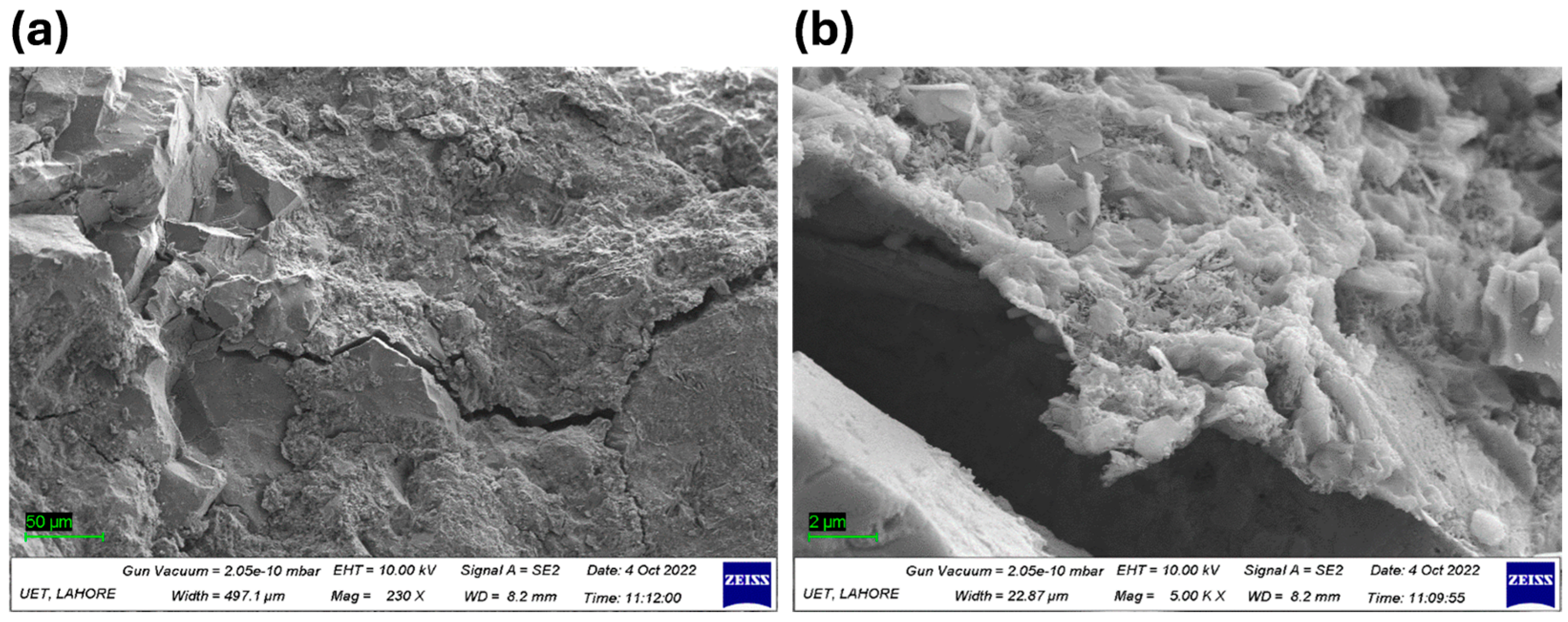
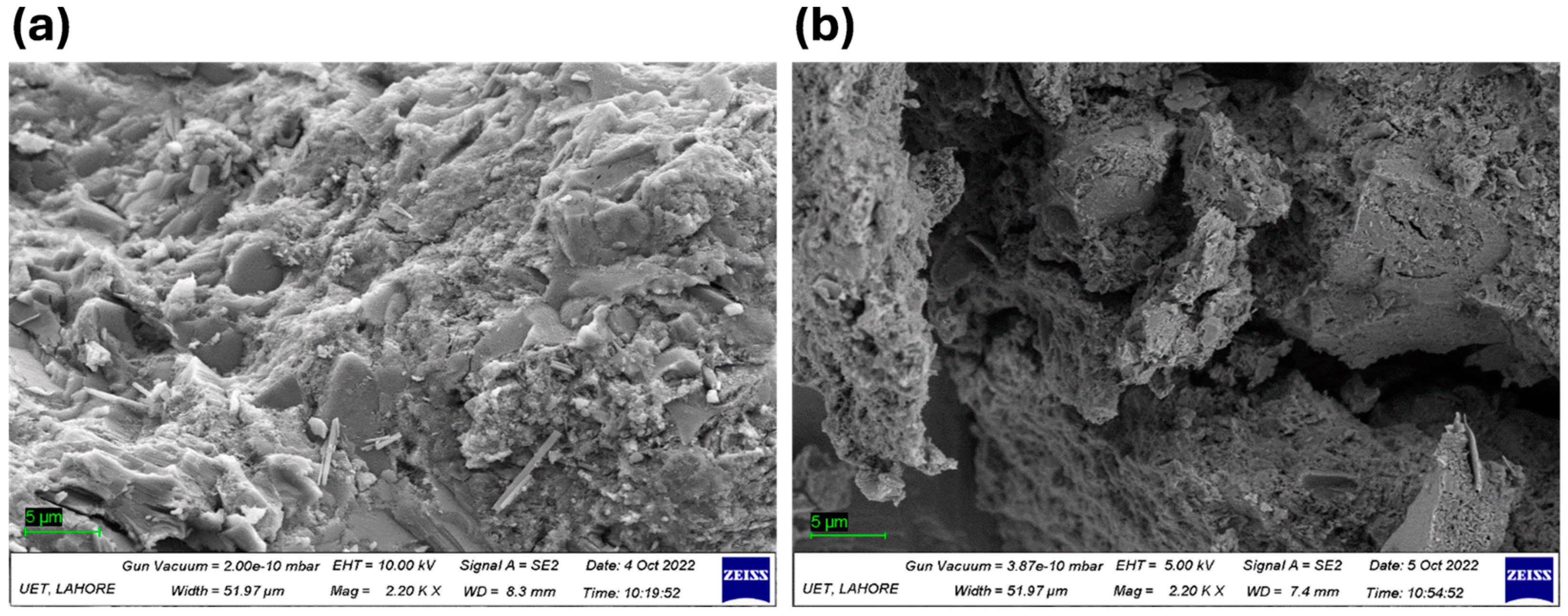
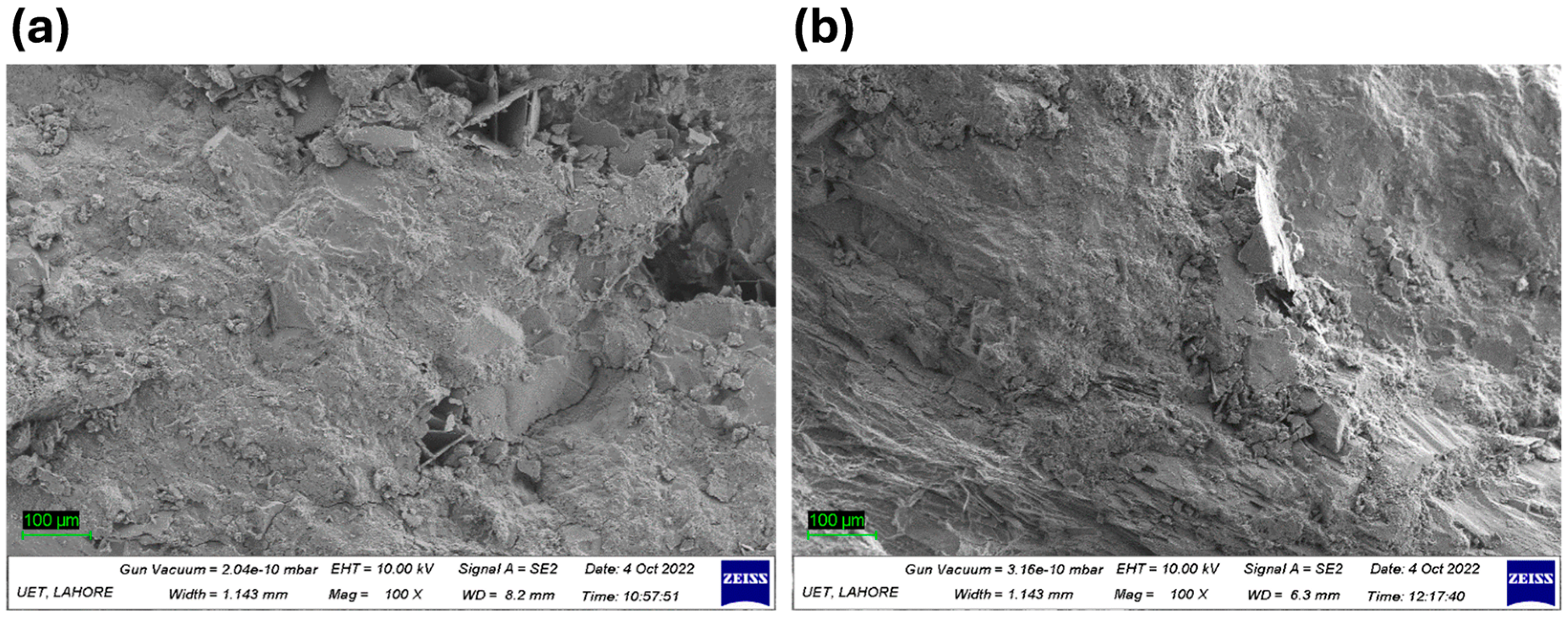

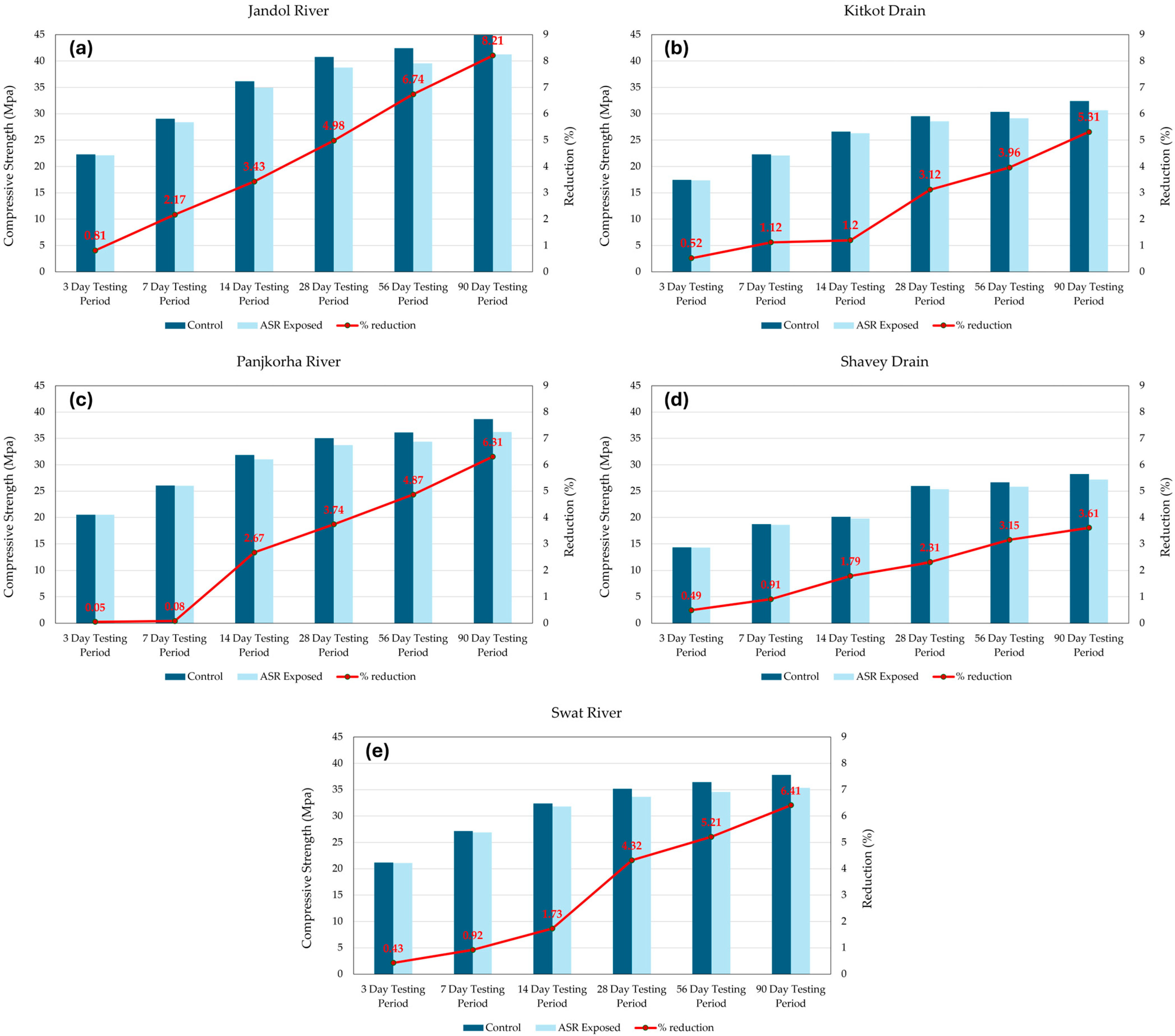
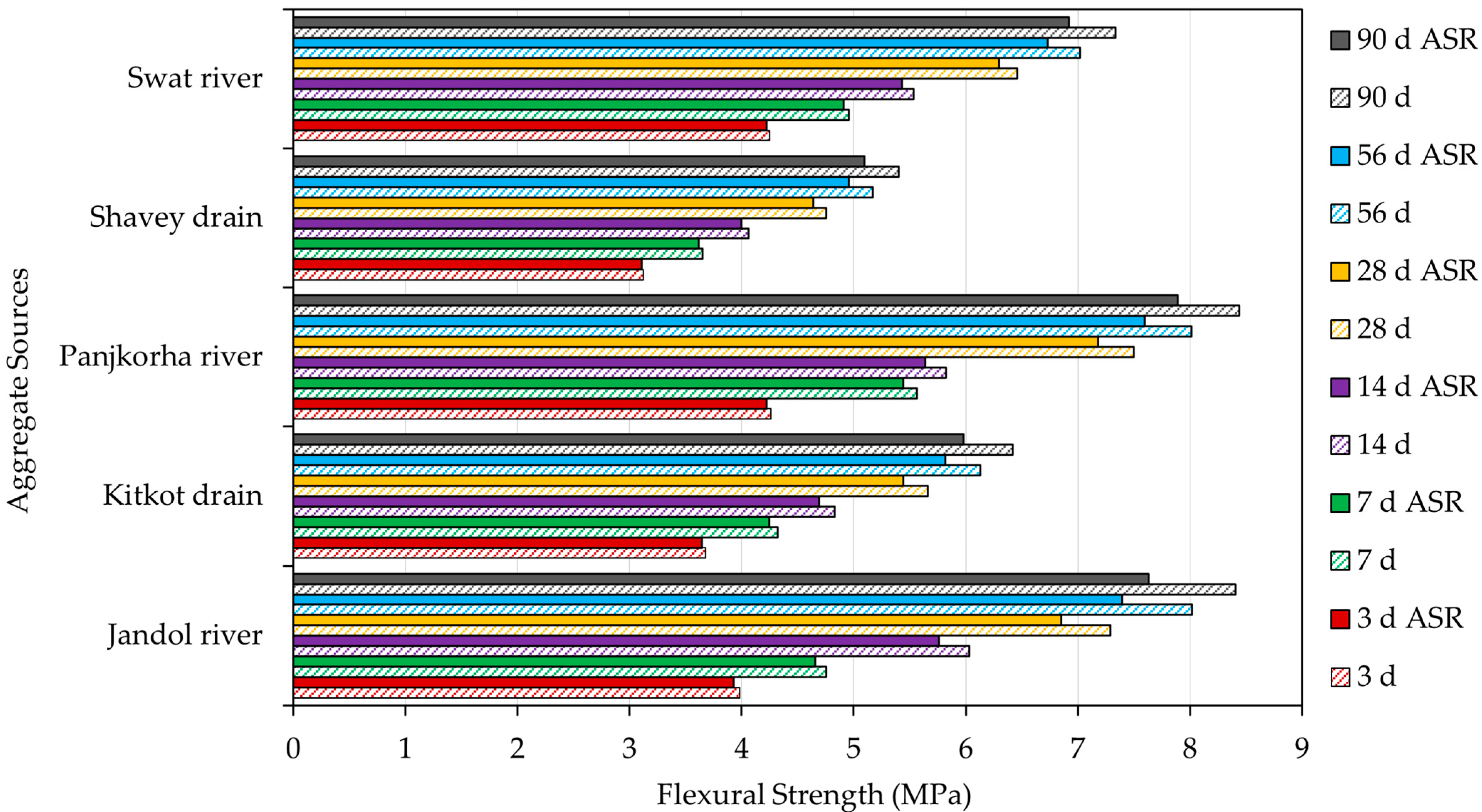
| Year | Studied Aggregates/Rock Formation | Test Performed | Results and Findings | Ref. |
|---|---|---|---|---|
| 2022 | Shalozan, Abbott abad, Orakzai agency, Swabi, and Sada | Physical and chemical properties, cube prism and accelerated mortar bar expansion, compressive strength, flexural strength, crushing strength, Los Angles abrasion, and impact test, petrographic analysis. | Physical properties of aggregates were within the specified ranges of ATSM standards. Swabi aggregates showed the highest resistance to crushing, abrasion, and impact. Orakzai and Shalozan aggregates have higher silica content, making them more reactive for ASR. Orakzai aggregates expanded by 0.119% at 14 days and 0.201% at 28 days, indicating reactivity. Specimens with Orakzai aggregates had a 9% decrease in flexural strength under ASR exposure compared to other sources. | [44] |
| 2020 | Sakesar limestone, Pail Padhrar, Tobar valley, Dhak pass. | Los Angeles abrasion value, soundness test, aggregate impact, aggregate crushing, specific gravity, and unit weight. | Aggregates from the Dhak Pass and Pail Padhar exhibited remarkably low abrasion values. The aggregates from Tobar Valley and Pail Padhar proved to be suitable options for the pavement surface course. In addition, the water absorption, specific gravity, and unit weight characteristics of all aggregates were within acceptable standards. | [45] |
| 2018 | Chakdara quarry, Katkala quarry, Gulabad Khwar, Pajkor River at Rani. | Specific gravity, water absorption, bulk density, flakiness index, elongation index, soundness, crushing value, impact value, Los Angeles abrasion, and concrete cylinder strength. | The quartet of extracted materials exhibited a diverse range of characteristics, consisting of specific gravity, bulk density, and water absorption, which ranged from 2.67 to 2.72, 99 lb/ft3 to 101 lb/ft3, and 1.58% to 1.92%, respectively. Flakiness and elongation indices ranged from 21.1% to 25.1% and 14.7% to 24.2%, respectively. Soundness tests gave results between 3.35% and 5.04%. Aggregates from the Gulabad quarry emerged as star performers in both the crushing and impact tests, recording the most commendable values of 13.23% and 16.56%, respectively. Among the tested sources, the Gulabad aggregate had the highest concrete cylinder strength (2376 psi). | [46] |
| 2018 | The area around Loni Kot (Karachi-Hyderabad Motorway). | Particle size, water absorption, bulk density, solidity, organic impurities, clay lumps, friable particles, flakiness and elongation index, Los Angeles abrasion test, crushing value, and impact value. | Approximately 77% of the fine particles were reported to be free of organic impurities. Coarse aggregates exhibited water absorption rates ranging from 0.20% to 0.60%, while their fine counterparts exhibited a wider range of 0.40% to 2.20%. Specific gravity for fine aggregates ranged from 2.42 to 2.72 and for coarse aggregates from 1.95 to 2.87. Notably, 25% and 27% of the coarse aggregates were identified as flaky and elongated particles, respectively. The impact value and aggregate crushing value were 25% and 28%, respectively. | [47] |
| 2017 | The Kamser Mountains from Muzaffarabad in Kashmir, the Jhelum River at the Lehri Mangla, the Sheikh Hills, Tuguwali Hills, and Mach Hills from the Sargodha region. | Expansion test, petrographic analysis. | According to ASTM C227, aggregates sourced from the Sargodha region exhibited mortar bar expansion values ranging from 0.05% to 0.07%. In stark contrast, aggregates sourced from the Jhelum and Kamser regions exhibited significantly lower expansion rates, falling below 0.04%. However, a concerning revelation emerged during the ASTM C1260 test, where all aggregates from the Sargodha region showed reactivity, with expansions exceeding the critical threshold of 0.20%. This unsettling trend was confirmed by petrographic analysis, further highlighting the risk posed by these aggregates. | [48] |
| 2017 | Sargodha, Mangla, and Margalla crush, as well as Banalla crush. | Specific gravity, water absorption, bulk density, impact value, concrete cylinder strength, splitting tensile strength, and flexural. | Margalla crushes exhibited the most remarkable specific gravity among the samples, while Sargodha and Barnala crushes exhibited lower water absorption rates compared to Margalla and Mangla crushes. Interestingly, Margalla crush exhibited the lowest bulk density within the group. Sargodha Crush exhibited the lowest impact value (11.6%) and crushing value (17.9%) among all the samples. Conversely, Margalla crushes demonstrated the maximum flexural capacity (4.90 MPa) and compressive capacity (26.3 MPa) among the tested aggregates. Barnala crushed stone exhibited the highest splitting tensile strength within the evaluated parameters. | [49] |
| 2016 | Malikhore formation (Lasbela and Khuzdar districts). | Compressive strength, Los Angeles abrasion, flakiness, elongation index, bulk density, Alkali–Silica reactivity, and petrographic analysis. | The results showed a specific gravity of 2.74 and a water absorption rate of only 0.28%. Impressively, the compressive strength increased to 6179 psi, while the Los Angeles abrasion test showed a value of 23%. Given these robust properties, the aggregates were considered well suited for concrete production, as confirmed by petrographic analysis. | [50] |
| 2015 | Obhan Shah quarry (OSQ), Chattan Shah quarry (CSQ), Goal Pahari quarry (GPQ), Darak quarry (DQ) and Jara Takar quarry (JTQ). | Specific gravity, bulk density, flakiness and elongation index, water absorption, crushing value, impact value, abrasion value, and compressive strength | Each of the aggregate sources had specific gravities that met the established standards, but their bulk densities remained below 2400 kg/m3. All sources exceeded the specified limit of 15% for the flakiness index. The water absorption, crush, impact, and abrasion values of each source were within acceptable parameters. Notably, JTQ had the lowest compressive strength of 20.8 MPa, while CSQ had the most remarkable 28-day compressive strength, rising to an impressive 38.2 MPa. | [51] |
| 2014 | Limestones from Margala Hill (MH), Lockhart (LT), Kawagarh (KW), Sammana Suk (SM), and Shekhai (SH). | Los Angeles abrasion, impact value, flakiness index, elongation index, density, water absorption, and petrographic analysis | All mechanical and physical properties were well within the tolerances of both BS and ASTM standards. Among them, KW had the highest specific gravity. Kawagarh and Sammana Suk exhibited the lowest Los Angeles abrasion values and impact values, respectively. | [52] |
| 2013 | Hajra, Kamser, Arja, Margalla and Sargodha crush. | Unit weight, flakiness and elongation index, impact value, crushing value, compressive strength, tensile strength specific gravity, water absorption. | The three Kashmiri sources, namely Hajra, Kamser, and Arja, exhibited specific gravities that fell within the spectrum delineated by the Margalla and Sargodha crushes. Kamser and Hajra had the lowest water absorption rates among the Kashmiri sources. All Kashmiri sources exhibited flakiness and elongation indices towel within the BS standards. The impact values ranged from 10 to 15%, while the crushing values ranged from 15 to 23%. The Kamser aggregates had the lowest compressive and tensile strength values, while the Arja aggregates had the highest values for both compressive and tensile strength. | [53] |
| 2012 | Bara River, Basi, LoyeKhawar, Zangali/JaniKhawar | Los Angeles abrasion, ASR, Petrographic examination, Bulk density, Soundness. | Aggregate samples from the Bara River, Basi, Zangali, and Loye Khawar showed a spectrum of bulk densities ranging from 2.3 to 3.1. The soundness test revealed a tapestry of values that resonated with the intrinsic character of each quarry: 13.05, 6.61, 8.94, and 17.69. Abrasion test revealed their resilience with values of 21.2, 18.5, 24, and 20, respectively, crafting a narrative of endurance and strength. No expansion was observed, each sample standing as a testament to its harmlessness. Delicate strokes of petrographic analysis then painted a portrait of purity, revealing reactive carbonates or the shadow of unstable silica. | [54] |
| 2009 | Jurana formation, Sakesar limestone | Specific gravity, water absorption, soundness test, Los Angeles abrasion, moisture content. | The specific gravities ranged from 2.62 to 2.70, with water absorption ranging from a minimum of 0.44% to a slightly higher 1.30%. After five immersion cycles, the soundness test revealed a spectrum from 2.15% to 8.47%, indicating of the aggregates. Abrasion values, ranging from 18.6% to 29.4%, underscored their durability. Maximum dry density went from 143 to 144.8 pounds per cubic foot, while optimum moisture content was found to be 5.4% to 5.6%. These results underscore the suitability of the tested aggregates for road construction. | [55] |
| 2009 | Allai aggregate | Bulk density, specific gravity, water absorption and ASR. | Although the techical properties of the aggregates were within standard limits, their potential for Alkali–Silica reaction was noted. As a precautionary measure, it is recommended that these aggregates be incorporated into concrete mixes along with mitigating agents such as fly ash, slag, and low alkali cement. This strategic approach aims to minimize the risk of Alkali–Silica reactions and ensure the durability and longevity of concrete structures. | [56] |
| 2008 | Girdue limestone, Sakhi Sarwar, Pitok quarry, Uzman quarry at Nullah Zungi, Khalgeri Mullah quarry | Specific gravity, water absorption, soundness test, Los Angeles abrasion, moisture content, CBR value. | Specific gravities ranged from 2.61 to 2.69 and water absorption from 0.57% to 1.65%. Soundness test values ranged from 1.80 to 3.77%, while abrasion values ranged from 17.9% to 30.6%. Maximum dry density ranged from 143.7 to 144.9 lb/ft3, with optimal damp concentration observed between 5.2% and 5.4%. Notably, the California bearing ratio ranged from 84.4% to 99.2%, indicating favorable conditions for surface preparation and concrete work, particularly sourced from the Girdu formation. | [57] |
| 2006 | Chiniot, Margala, Sikhanwali, Takial and Khairabad. | Crushing value, abrasion value, specific gravity, porosity and particle shape index. | Crush values ranged from 21.78% to 29.20%, while the Los Angeles abrasion values were from 16.3% to 25.46%. Impact values ranged from 12.73% to 18.65%. Upon close inspection, the Margala and Chiniott sources emerged as paragons of minimalism, boasting the lowest porosity, crushing value, and impact value, compared to the grandeur of the highest specific gravity values. However, amidst this tapestry of attributes, the Margalla source aggregate emerged with regal distinction, adorned with the highest quotient of flaky and elongated particles, adding complexity to its narrative. | [58] |
| Sr. No. | Aggregate Sources | Latitude | Longitude |
|---|---|---|---|
| 1 | Swat River (Naseeb crush plant chakdara) | 34°41′24″ N | 72°01′47″ E |
| 2 | Panjkorha (river Malik and ko block crush shakwali temargara) | 34°47′28″ N | 71°48′48″ E |
| 3 | Kitkot khwar (Mamund block factory Barkaly) | 34°47′31″ N | 71°24′16″ E |
| 4 | Shavey khwar (Bilal crush plant Dir) | 34°51′48″ N | 71°40′4.9″ E |
| 5 | Jandool river (raghagan dam water resort salarzai) | 34°46′23″ N | 71°37′06″ E |
| Aggregate Sources | Crusher Site | Aggregate Sample |
|---|---|---|
| River Swat aggregates | 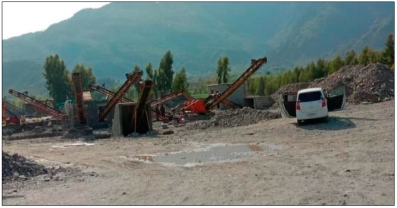 | 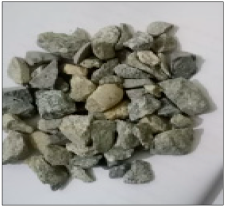 |
| River Panjkorha aggregate | 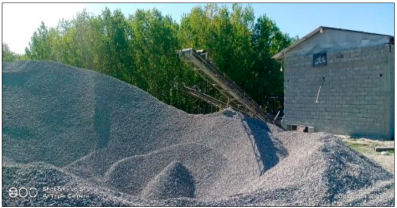 | 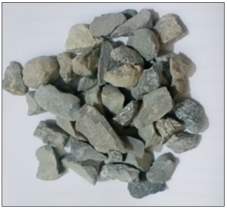 |
| River Jandool aggregates | 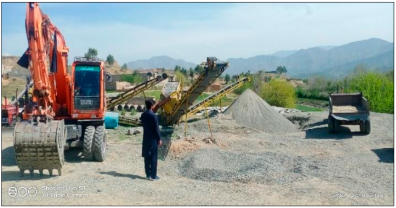 | 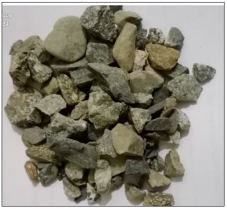 |
| Shavey Drain aggregates | 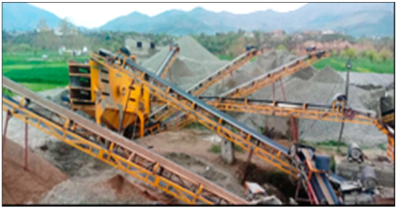 | 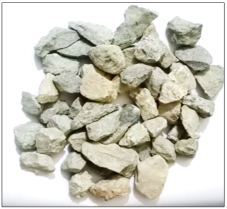 |
| Kitkot Drain aggregates | 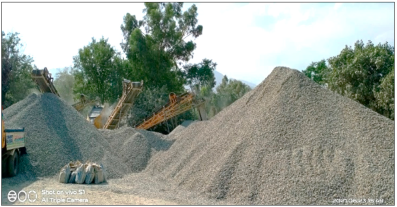 | 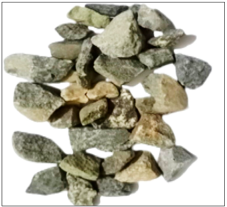 |
| Characteristic | Reference Standard | Value | Reference Limit |
|---|---|---|---|
| Standard Consistency | ASTM C187 [63] | 26% | --- |
| Initial Setting Time | ASTM C191 [62] | 85 min | >45 min |
| Final Setting Time | ASTM C191 [62] | 175 min | <375 min |
| Fineness (Passing #200) | ASTM C184 [61] | 98.6% | ≥90% |
| Fineness (Blaine Air Permeability) | ASTM C204 [60] | 2996 cm2/g | ≥2250 cm2/g |
| Soundness | EN 196-3 [59] | 0.80 mm | ≤10 mm |
| Aggregate Source | Bulk Density (kg/m3) | Specific Gravity (---) | Water Absorption (%) | Impact Value (%) | Crushing Value (%) | Abrasion Value (%) |
|---|---|---|---|---|---|---|
| Swat River | 1490.6 | 2.75 | 0.59 | 20.56 | 20.44 | 21.34 |
| Panjkorha River | 1460.4 | 2.72 | 0.61 | 21.56 | 21.56 | 23.12 |
| Jandol River | 1510.7 | 2.79 | 0.71 | 18.53 | 18.53 | 20.10 |
| Shavey Drain | 1410.0 | 2.64 | 0.97 | 21.54 | 21.54 | 29.87 |
| Kitkot Drain | 1430.3 | 2.69 | 0.81 | 27.31 | 27.31 | 28.41 |
| Constituents | Swat River | Panjkora River | Jandool River | Shavey Drain | Kitkot Drain |
|---|---|---|---|---|---|
| CaO (%) | 0.88 | 0.75 | 0.93 | 1.45 | 1.85 |
| MgO (%) | 0.32 | 0.39 | 0.28 | 0.20 | 0.72 |
| SiO2 (%) | 92.5 | 89.9 | 94.7 | 88.4 | 85.2 |
| SO3 (%) | 0.16 | 0.12 | 0.23 | 0.13 | 0.22 |
| Al2O3 (%) | 1.45 | 2.89 | 0.52 | 1.20 | 1.67 |
| Fe2O3 (%) | 0.67 | 0.75 | 0.25 | 0.34 | 0.40 |
| L.O.I (%) | 1.24 | 1.88 | 1.44 | 1.87 | 2.69 |
Disclaimer/Publisher’s Note: The statements, opinions and data contained in all publications are solely those of the individual author(s) and contributor(s) and not of MDPI and/or the editor(s). MDPI and/or the editor(s) disclaim responsibility for any injury to people or property resulting from any ideas, methods, instructions or products referred to in the content. |
© 2025 by the authors. Licensee MDPI, Basel, Switzerland. This article is an open access article distributed under the terms and conditions of the Creative Commons Attribution (CC BY) license (https://creativecommons.org/licenses/by/4.0/).
Share and Cite
Yousaf, M.; Zafar, M.S.; Usman, M.; Usama, M.; Yousaf, M.U.; Scaccianoce, G.; Cirrincione, L.; Vocciante, M. Alkali–Silica Reactivity Potential of Aggregates from Different Sources in Pakistan. Sustainability 2025, 17, 3203. https://doi.org/10.3390/su17073203
Yousaf M, Zafar MS, Usman M, Usama M, Yousaf MU, Scaccianoce G, Cirrincione L, Vocciante M. Alkali–Silica Reactivity Potential of Aggregates from Different Sources in Pakistan. Sustainability. 2025; 17(7):3203. https://doi.org/10.3390/su17073203
Chicago/Turabian StyleYousaf, Muhammad, Muhammad Shajih Zafar, Muhammad Usman, Muhammad Usama, Muhammad Usman Yousaf, Gianluca Scaccianoce, Laura Cirrincione, and Marco Vocciante. 2025. "Alkali–Silica Reactivity Potential of Aggregates from Different Sources in Pakistan" Sustainability 17, no. 7: 3203. https://doi.org/10.3390/su17073203
APA StyleYousaf, M., Zafar, M. S., Usman, M., Usama, M., Yousaf, M. U., Scaccianoce, G., Cirrincione, L., & Vocciante, M. (2025). Alkali–Silica Reactivity Potential of Aggregates from Different Sources in Pakistan. Sustainability, 17(7), 3203. https://doi.org/10.3390/su17073203









